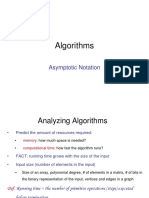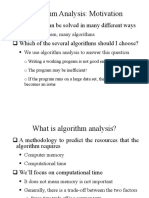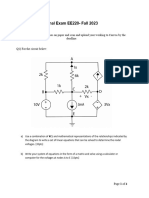0% found this document useful (0 votes)
95 views57 pagesData Structures and Algorithms - L2
This document provides an introduction to algorithms and data structures. It defines what an algorithm is, using examples of sorting algorithms. It discusses how to analyze and compare the efficiency of different algorithms using techniques like asymptotic analysis and Big-O notation. Analyzing the number of basic operations allows estimating the running time of an algorithm as a function of the input size n. The document emphasizes that asymptotic analysis provides a hardware-independent way to compare algorithms and is more useful than empirical testing alone.
Uploaded by
vidulaCopyright
© © All Rights Reserved
We take content rights seriously. If you suspect this is your content, claim it here.
Available Formats
Download as PPT, PDF, TXT or read online on Scribd
0% found this document useful (0 votes)
95 views57 pagesData Structures and Algorithms - L2
This document provides an introduction to algorithms and data structures. It defines what an algorithm is, using examples of sorting algorithms. It discusses how to analyze and compare the efficiency of different algorithms using techniques like asymptotic analysis and Big-O notation. Analyzing the number of basic operations allows estimating the running time of an algorithm as a function of the input size n. The document emphasizes that asymptotic analysis provides a hardware-independent way to compare algorithms and is more useful than empirical testing alone.
Uploaded by
vidulaCopyright
© © All Rights Reserved
We take content rights seriously. If you suspect this is your content, claim it here.
Available Formats
Download as PPT, PDF, TXT or read online on Scribd
/ 57

































































































